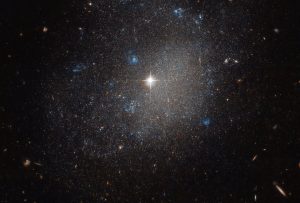Puntinismo stellare
In una limpida notte dell’aprile 1789 l’astronomo William Herschel, mentre proseguiva la sua inarrestabile esplorazione del cielo notturno, individuò un nuovo oggetto cosmico ed ebbe occasione di festeggiare! Incrementando la sua lista straordinaria di scoperte ancora una volta, l’astronomo osservò questa brillante galassia a spirale, chiamata NGC 4707, nella costellazione dei Cani da Caccia. NGC 4707 si trova a circa 22 milioni di anni luce dalla Terra.
Oltre due secoli più tardi il telescopio Hubble osserva la stessa galassia con dettaglio molto maggiore di quanto fosse possibile a Herschel, permettendoci di apprezzare la complessità e le caratteristiche di NGC 4707 come mai prima d’ora.
Lo stesso Herschel, secondo quanto riportato, ha descritto NGC 4707 come una galassia “piccola, stellare”. Anche è stata classificata come spirale, la forma generale della galassia, il centro e i bracci di spirale sono molto leggeri o inesistenti. Ha invece l’aspetto artistico di una spruzzata di stelle e di pennellate blu su una tela scura, come se un pittore avesse punteggiato il cosmo con piccoli puntini di pittura dal colore acceso.
Le macchie blu visibili nell’immagine evidenziano regioni di formazione stellare recente o in corso, ricche di astri neonati che riplendono con brillanti, intense sfumature di ciano e turchese.
[ Barbara Bubbi ]
http://www.spacetelescope.org/images/potw1651a/
Credit:ESA/Hubble & NASA

Lascia un commento